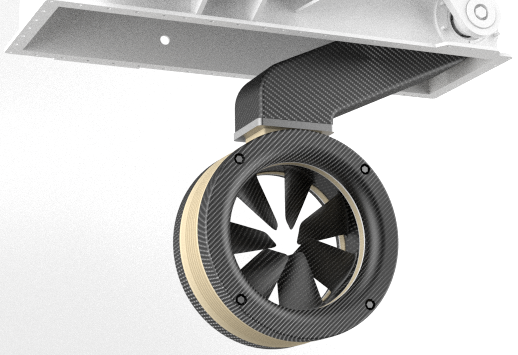Rim-driven Thruster on:
[Wikipedia]
[Google]
[Amazon]


 The rim-driven thruster, also known as rim-driven propulsor/propeller (or RDP) is a novel type of electric propulsion unit for ships. The concept was proposed by Kort around 1940, but only became commercially practical in the early 21st century due to advances in DC motor controller technology. As of 2017, commercial models of between 500 kW and 3MW are available from manufacturers such as Rolls-Royce, Schottel, Brunvoll, Voith, Van der Velden, etc.
The rim-driven thruster, also known as rim-driven propulsor/propeller (or RDP) is a novel type of electric propulsion unit for ships. The concept was proposed by Kort around 1940, but only became commercially practical in the early 21st century due to advances in DC motor controller technology. As of 2017, commercial models of between 500 kW and 3MW are available from manufacturers such as Rolls-Royce, Schottel, Brunvoll, Voith, Van der Velden, etc.
Are Rim-Driven Propulsors The Future? (Royal Institution of Naval Architects)
Rim Motors Drive Thruster Development (Riviera Newsletters)
Marine propulsion

Principle
The rim-driven thruster is a marine propeller that does not use a central hub for transmission of the driving torque. Conventional hubcentric propellers typically use a shaft driven by aturbine
A turbine ( or ) (from the Greek , ''tyrbē'', or Latin ''turbo'', meaning vortex) is a rotary mechanical device that extracts energy from a fluid flow and converts it into useful work. The work produced by a turbine can be used for generating ...
, a diesel engine
The diesel engine, named after Rudolf Diesel, is an internal combustion engine in which ignition of the fuel is caused by the elevated temperature of the air in the cylinder due to mechanical compression; thus, the diesel engine is a so-ca ...
or an electric motor
An electric motor is an electrical machine that converts electrical energy into mechanical energy. Most electric motors operate through the interaction between the motor's magnetic field and electric current in a wire winding to generate for ...
. The more recent podded drives consist of a propeller driven by a conventional electric motor into an azimuthable gondola under water, but they still incorporate a traditional hubcentric propeller.
The blades of the rim-driven thruster, by contrast, are mounted on an outer ring rather than a central hub. The ring constitutes the rotor of an electric motor and sits within a surrounding stator, which is also ring-shaped and creates the necessary torque. Rotor and stator are water tight and the whole unit operates submerged. Similar to an azipod, a rim-driven thruster can be designed to be fixed, retractable and/or azimuthing.
Advantages and disadvantages
The largest advantages of the rim-driven thruster are lower noise emissions, potentially increased efficiency, and a compact design that enables relatively simple integration in many applications. Since the propeller blade/rotor assembly is driven directly by electro-magnetic forces, no shaft and no gearbox is needed. The blades can be made of metal or composite material, and the rotor and stator can be hermetically sealed. Since the blades are mounted to the rotor ring, there is no tip gap (which can be a noise source in ducted propellers) and the elimination of a mechanical gearbox also removes a prominent sources of noise. The primary disadvantage is the complexity of manufacturing high-output submerged motors with water-lubricated bearings. The potential efficiency improvements might also be tricky to achieve due to friction losses in the gap between the rotor and its surrounding stator. And as with all high-output electric motors, sufficient cooling can present problems even for units submerged in water.See also
* Manoeuvering thruster *Azimuth thruster
An azimuth thruster is a configuration of marine propellers placed in pods that can be rotated to any horizontal angle (azimuth), making a rudder unnecessary. These give ships better maneuverability than a fixed propeller and rudder system.
Ty ...
*Azipod
Azipod is a trademark azimuth thruster pod design, a marine propulsion unit consisting of a fixed pitch propeller mounted on a steerable gondola ("pod") containing the electric motor driving the propeller, allowing ships to be more maneuverabl ...
*Z-drive
A Z-drive is a type of marine propulsion unit. Specifically, it is an azimuth thruster. The pod can rotate 360 degrees allowing for rapid changes in thrust direction and thus vessel direction. This eliminates the need for a conventional rudder.
...
*Cycloidal drive
A cycloidal drive or cycloidal speed reducer is a mechanism for reducing the speed of an input shaft by a certain ratio. Cycloidal speed reducers are capable of relatively high ratios in compact sizes with very low backlash.
The input shaft dr ...
*Propulsor {{short description, Mechanical device to propel a vessel
A propulsor is a mechanical device that gives propulsion. The word is commonly used in the marine vernacular, and implies a mechanical assembly that is more complicated than a propeller. Th ...
*
References
{{ReflistExternal links
Are Rim-Driven Propulsors The Future? (Royal Institution of Naval Architects)
Rim Motors Drive Thruster Development (Riviera Newsletters)
Marine propulsion